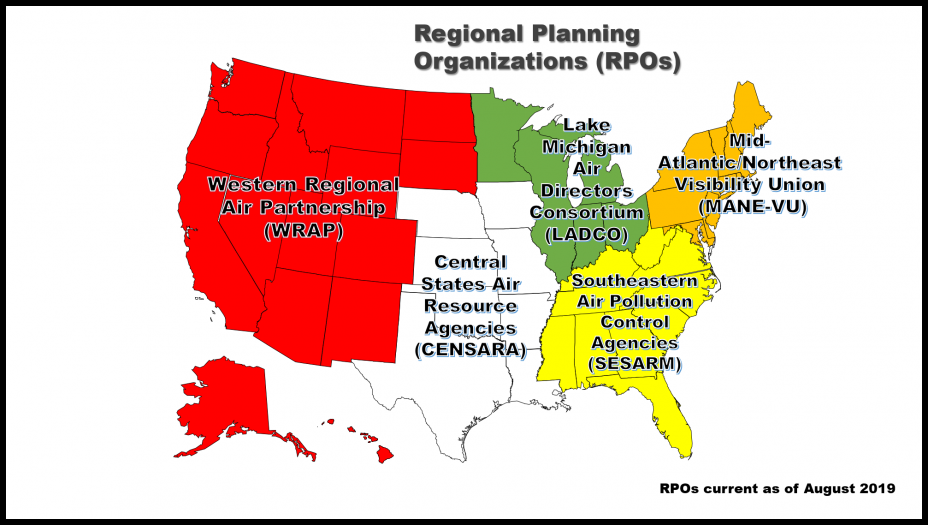Visibility - Regional Planning Organizations
Because the pollutants that lead to regional haze can originate from sources located across broad geographic areas, EPA has encouraged the States and Tribes across the U.S. to address visibility impairment from a regional perspective. These organizations evaluate technical information to better understand how their States and Tribes impact national parks and wilderness areas (Class I areas) across the country, pursue the development of regional strategies to reduce emissions of particulate matter and other pollutants leading to regional haze, and help states meet the consultation requirements of the Regional Haze Rule.
Below is a map of the Regional Planning Organizations (RPOs):

The five Regional Planning Organizations (RPOs) are:
Western Regional Air Partnership (WRAP).Exit The WRAP is the successor organization to the Grand Canyon Visibility Transport Commission, which was formed in 1991 and issued recommendations to EPA in 1996 for improving the air quality in the 16 Class I areas on the Colorado Plateau. The Western States Air Resources Council (WESTAR) is working in cooperation with the WRAP. Nine WRAP states (Arizona, California, Colorado, Idaho, Nevada, New Mexico, Oregon, Utah, Wyoming) now have the option of implementing many of the Commission's recommendations within the framework of the national regional haze rule.
Central States Air Resource Agencies (CENSARA)Exit CenSARA promotes the exchange of air quality information, knowledge, experience, and data among and between participating organizations and other interested parties. Includes eight states—Nebraska, Kansas, Oklahoma, Texas, Iowa, Missouri, Arkansas, and Louisiana.
Lake Michigan Air Directors Consortium (LADCO).Exit LADCO works with federal, state, tribal, and local air agencies to improve air quality in the Great Lakes region. Includes six states—Illinois, Indiana, Michigan, Minnesota, Ohio, and Wisconsin.
Mid-Atlantic/Northeast Visibility Union (MANE-VU)Exit Includes Connecticut, Delaware, the District of Columbia, Maine, Maryland, Massachusetts, New Hampshire, New Jersey, New York, Pennsylvania, Rhode Island, Vermont, Northern Virginia, and suburbs of Washington, D.C. The Northeast States for Coordinated Air Use Management (NESCAUM) and Mid-Atlantic Regional Air Management Association (MARAMA) are working in cooperation with the OTC on regional haze issues.
Southeastern Air Pollution Control Agencies (SESARM) Exit Throughout its history, SESARM's mission has remained constant—to help the staff of state air pollution control agencies to improve their knowledge and effectiveness in management of air quality through advocacy, facilitating communications, scheduling and hosting directors' meetings, program manager workshops, and training courses, conducting technical air quality analysis, and providing travel support. Member States and Tribes include: the States of Alabama, Florida, Georgia, Kentucky, Mississippi, North Carolina, South Carolina, Tennessee, Virginia, and West Virginia and the Eastern Band of the Cherokee Indians.
